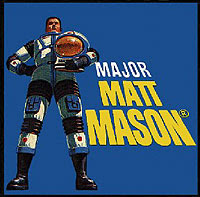MMM Space Station - What is it?
Certainly
one of the most spectacular and imaginative "play-houses" ever
produced, the Space Station was Mattel's Man in Space moon habitat.
Comprised of two hexagonal grid-like platforms, joined by orange girders
and topped by a unique, lit control center, the Space Station provided
hours of entertainment for the aspiring young astronaut. Roughly 26"
tall to the top of the Beacon, the Space Station was and still is an
awe-inspiring sight. Imagine a real astronaut viewing this structure on
the
Moon's surface upon first arrival or at the finish of a tough
"work-day". The designers of this unique structure should be applauded
for their vision and ingenuity.
The Space Station could be assembled and reassembled in several
configurations. Mattel's idea was to promote the purchase of several
Stations that could be built-up together to form a large structure,
comprised of several levels and off-shoot platforms. Various space tasks
could then be performed atop the platforms, such as staging Satellite
or Space Probe Launches. Access through the platforms could be done via
the girder system or center hole-opening.
The top-most platform could be built-up into a Command Center with
central console, viewing screens and shelving. The entire Command Center
was surrounded by Solar Shields to protect the astronauts from the
"elements." These Shields could be lowered via hinged-connectors at
their bottoms to swing down for access to the Command Center
compartment. The Command Center came complete with communication console
including a wired microphone, and a sink for washing off that pesky
lunar dust. Each of the tripod-like legs of the center was attached
to the platform via locking pins (usually a pin or tow is missing/broken in most examples found
these days).
To further enhance the functionality of the Space Station, the Space
Crawler could ingeniously be mounted to the top to act as an
electronic-mechanical crane
(how the astronauts would get it up there wasn't detailed in the
description - appears the benevolent "magic crane" - aka a child's hand -
could be used!). With the Space Crawler removed, the Space-Radar Beacon
could be stood upright or inserted upside down to light the transparent
screen for
eerie effect. In all, a wonderful set-up designed for hours of
imaginative play.
Space Station Images:
Sticker Sheet:
Instructions:
Mattel #6308-0922 Space Station Front and Back
Mattel #6308-0922 Space Station Inside Pages
Patents:
N/AMaladies:
- Melts in the station chair (happens when a figure is left in the cockpit) or white station platforms
- Missing faucet, microphone, console shelf, chair, locking pins
- Broken girder tabs (so they don't interlock)
- Brocken, scratched or missing clear radiation shields
- Missing console celo
- Missing beacon battery cover
- Missing beacon dome
- Missing beacon GE401 Bulb
- Corroded Contacts
Variations:
- Some station tops have the hole for the shelf uprights drilled through, while others are solid.
- Some shields and upright girders have variations in color
- Mexican Cipsa Station Espacial
- Different plastic colors for the girders (more a burgundy color)
- Darker clear blue plastic for Beacon dome and shields
- 6-finned Beacon in white
- Unpainted Chair Back (plain white instead of blue)
- Paper Console tube
John's Notes:
I still vividly remember the first Major Matt Mason commercial that I saw in black-and-white. It prominently showed the eerie Space Station and I immediately wanted one. Of course I had to wait until I was an adult to actually own one, but did get to experience the Station at a neighbor's house as a kid.I have several prototype Space Stations in my possession and it is interesting that the platforms were originally designed as six separate panels that would snap together. I believe the original intent was to build the station as a kit, similar to an erector set. I think that the idea was abandoned as the Station would be too unstable assembled in this fashion. More pics coming soon in my Real Prototypes section. Also, you'll note that the box images are quite different from the actual production model. At some point, Mattel chose to brighten up the toy-line by changing the typical silver/gray color to bright orange. There are also several detailing changes (like the legs of the command center) that were changed. I'll have images of these with comparison's to the production model's corresponding parts in my Prototype update.
Some other interesting box tidbits: The pictured Satellite Launcher has a red satellite (not used in production). Some astronauts are wearing belts with holstered guns; there's a "D"-cell flashlight in the command center's shelf. The Space Shields have been replaced by clear panels for the photography. Probably so that the lines of the molded panels would not obscure the details of the interior. Also, these shields are only present on the back panels...front panels are drawn-in lines, evidenced by the lack of reflection.
Accessory may also be found in:
All Mattel images and captions are copyright
Mattel and used without permission. All other content, including images
and editorial, is Copyright © 1997-2023 John Eaton and/or contributors
unless otherwise stated. If there are any comments or objections,
please contact John Eaton.















No comments:
Post a Comment